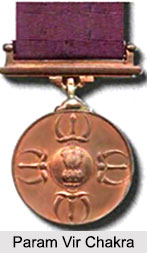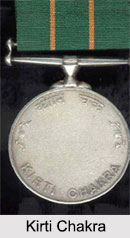 Indian Defence Awards were constituted to recognize and honor the services of the Indian Defence Force. Since remote past, different countries have been honoring excellence, outstanding services and achievements in a wide range of fields. In India, this recognition has taken a number of forms including awarding of medals. Indian Defence Awards are given by the President of India.
Indian Defence Awards were constituted to recognize and honor the services of the Indian Defence Force. Since remote past, different countries have been honoring excellence, outstanding services and achievements in a wide range of fields. In India, this recognition has taken a number of forms including awarding of medals. Indian Defence Awards are given by the President of India.
Types of Indian Defence Awards
Indian Defence Awards can be divided into two categories namely, the awards given for gallantry shown while fighting the enemy known as the Gallantry Awards and those given for bravery other than fighting the enemy known as the Non Gallantry Awards.
Gallantry Awards
 The Gallantry Awards are again categorized into two main categories - those given for gallantry in the face of enemy and those given for gallantry displayed in situations other than in the face of enemy.
The Gallantry Awards are again categorized into two main categories - those given for gallantry in the face of enemy and those given for gallantry displayed in situations other than in the face of enemy.
Awards for gallantry in the face of enemy comprises of the prestigious awards like Param Vir Chakra, Maha Vir Chakra, Vir Chakra and Sena Medals namely, Nao Sena and Vayu Sena Medals. Param Vir Chakra is the highest honor given to military personnel for the display of courage and bravery. Maha Vir Chakra is the second highest honor given to military personnel for a brave deed on land or sea or air. Vir Chakra ranks third in terms of position in the list of Gallantry Awards and is awarded to military personnel, who have defended their country in times of need. Sena Medal is given to army men. It is a circular silver medal with a bayonet pointing upwards. Nao Sena Medal is a circular silver medal, with a naval crest on the obverse, exclusively presented to the navy personnel. Vayu Sena Medal was established by the President of India on 17th of June, 1960 and is awarded to the Indian Air Force in recognition of such individual acts of exceptional devotion to duty or courage, as having special significance to the Air Force.
The second category of gallantry award comprises of the esteemed awards like Ashoka Chakra, Kirti Chakra and Shaurya Chakra. Originally, these were named as Ashoka Chakra Class I, Class II and Class III. While Ashoka Chakra is awarded for the "most conspicuous bravery or some daring or pre-eminent valor or self-sacrifice" in situations other than in the face of the enemy, the Kirti Chakra is awarded for "conspicuous gallantry" in non-combatant situations. Both the Asoka Chakra and the Kirti Chakra can be awarded to recognize gallantry and courage of the military personnel as well as of civilians. The medals may be awarded posthumously. Shaurya Chakra is awarded to commemorate the valor of civilians and the military personnel.
Non-Gallantry Awards
Param Vishisht Seva Medal was founded in 1960 and recognizes peace-time service of the most exceptional order. Sarvottam Yudh Seva Medal recognizes highest degree of illustrious services in times of war or conflict or hostilities. Uttam Yudh Seva Medal is awarded for wartime illustrious services. Yudh Seva Medal also recognizes distinguished service during wartime. Other Non-Gallantry Awards are the Samar Seva Medal, Sainya Seva Medal, Raksha Medal, Sangram Medal, Wound Medal and 25th Independence Anniversary Medal.




















